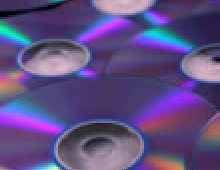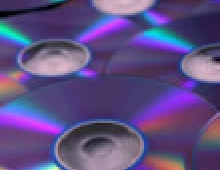
Recordable DVD looks like the hot commodity of 2003
Faster than you can say DVD+RW -- and figure out exactly what that means -- recordable DVD has zoomed out of nowhere and positioned itself for what promises to be a very steep rise popularity through the coming year.
Industry analysts offer boggling projections for sales of PC-based DVD recorders in 2003. After selling fewer than 1 million DVD recorders last year, the industry expects ramping sales to hit 3 million in 2002 -- then rocket up to 10 million for the year 2003. That rise roughly parallels the exploding success of DVD as a playback format; indeed, the prospects for consumer acceptance of recordable DVD is closely tied to the brief but phenomenal history of DVD itself.
In less than five years, DVD penetration of U.S. households has reached 53 percent -- a level that took the VCR more than a decade to achieve. Analysts attribute the format's speedy acceptance to its ease of use, durability, similarity to the already established CD and, perhaps above all those, the quality of picture and sound. Then, of course, there's the price factor.
When the first DVD players appeared in the spring of 1997, they typically sold for about $1,000. Today, it's a commodity product you can buy at the neighborhood drugstore for $69. That's not to say there aren't meaningful qualitative differences between bare-bones players and sophisticated machines that still may cost a few hundred dollars, but for a very modest outlay you can at least have a DVD player that gets the job done.
A similar slide in prices has begun with recordable DVD units, which until recently were bringing well over $500. The old expression is, "Don't look now, but..." Well, by all means do look now because you can buy a DVD burner for your PC for $350 or even $300. And as Robert DeMoulin, marketing manager for Sony's optical storage division, observes, when that price settles to $250 after another model change or two, the stampede will be on.
"Already, at $349 for our internal (PC) model DRU-500A, we can't make them fast enough," says DeMoulin. "We're literally selling every piece we produce. And I can see the price of a basic unit dropping to $199 next year."
Like the blank discs for recordable CD, recordable DVD media come in two formats: write-once (designated DVD-R), which means you can make one permanent recording, and rewritable (or DVD-RW), which allows you to reuse a disc. Write-once discs are cheaper, about $2, compared with $8 or more for rewritable. And those prices are down sharply from a year ago, when write-once DVD's cost $20 and reusable discs were about $30.
As if the discrepancy between R and RW didn't offer room enough for confusion, the blank discs also fall under two other subtypes: DVD-R/-RW and DVD+R/+RW. The usual way of expressing these (so you can keep up with the salesperson) is DVD minus R/RW and DVD plus R/RW. If the differences between the "minus" technology and its "plus" counterpart are not insignificant, for the end user they perhaps don't matter all that much. Most recent-model DVD players can accommodate both.
So what accounts for the great surge of enthusiasm for recordable DVD? Well, any curator of the family photo and video stash can offer one compelling answer. Photos fade, and after about 10 years the magnetic particles on video tape begin to fall off and you start to see drop-outs that cannot be restored.
That latter concern also stirs collectors of movies on tape to transfer their treasuries to the longer lasting medium of DVD, which industry experts now say should have a shelf life of at least 30 years. But don't count on copying the DVD you rent. You won't be able to do it, for a couple of insurmountable reasons.
First, there's the small matter of copy protection. You can't transfer the digital contents -- the "file," if you will -- of a DVD to another digital medium because a little flag pops up at the head of the bitstream that says, "Fuhgeddaboudit." But there's also another, less contentious obstacle.
Despite the tremendous storage capacity of a DVD, some 4.7 gigabytes compared with the 640 megabytes available on a blank CD, it still isn't nearly enough to hold the voluminous contents of a fully featured DVD movie release. Since a commercially produced DVD utilizes two layers of storage space, it can easily handle as much as 9 gigabytes of information. Multilayered DVD recorders may one day reach consumers, but that's still down the road and around the bend.
Of course, you can also use the vast storage of DVD to back up your computer. Remember that all-important data backup device, the Zip disc? One blank DVD represents the equivalent of 43 Zip discs. No doubt consumers will find unsuspected uses for DVD recorders. To judge from the sales projections, the creative thinking is well under way.
In less than five years, DVD penetration of U.S. households has reached 53 percent -- a level that took the VCR more than a decade to achieve. Analysts attribute the format's speedy acceptance to its ease of use, durability, similarity to the already established CD and, perhaps above all those, the quality of picture and sound. Then, of course, there's the price factor.
When the first DVD players appeared in the spring of 1997, they typically sold for about $1,000. Today, it's a commodity product you can buy at the neighborhood drugstore for $69. That's not to say there aren't meaningful qualitative differences between bare-bones players and sophisticated machines that still may cost a few hundred dollars, but for a very modest outlay you can at least have a DVD player that gets the job done.
A similar slide in prices has begun with recordable DVD units, which until recently were bringing well over $500. The old expression is, "Don't look now, but..." Well, by all means do look now because you can buy a DVD burner for your PC for $350 or even $300. And as Robert DeMoulin, marketing manager for Sony's optical storage division, observes, when that price settles to $250 after another model change or two, the stampede will be on.
"Already, at $349 for our internal (PC) model DRU-500A, we can't make them fast enough," says DeMoulin. "We're literally selling every piece we produce. And I can see the price of a basic unit dropping to $199 next year."
Like the blank discs for recordable CD, recordable DVD media come in two formats: write-once (designated DVD-R), which means you can make one permanent recording, and rewritable (or DVD-RW), which allows you to reuse a disc. Write-once discs are cheaper, about $2, compared with $8 or more for rewritable. And those prices are down sharply from a year ago, when write-once DVD's cost $20 and reusable discs were about $30.
As if the discrepancy between R and RW didn't offer room enough for confusion, the blank discs also fall under two other subtypes: DVD-R/-RW and DVD+R/+RW. The usual way of expressing these (so you can keep up with the salesperson) is DVD minus R/RW and DVD plus R/RW. If the differences between the "minus" technology and its "plus" counterpart are not insignificant, for the end user they perhaps don't matter all that much. Most recent-model DVD players can accommodate both.
So what accounts for the great surge of enthusiasm for recordable DVD? Well, any curator of the family photo and video stash can offer one compelling answer. Photos fade, and after about 10 years the magnetic particles on video tape begin to fall off and you start to see drop-outs that cannot be restored.
That latter concern also stirs collectors of movies on tape to transfer their treasuries to the longer lasting medium of DVD, which industry experts now say should have a shelf life of at least 30 years. But don't count on copying the DVD you rent. You won't be able to do it, for a couple of insurmountable reasons.
First, there's the small matter of copy protection. You can't transfer the digital contents -- the "file," if you will -- of a DVD to another digital medium because a little flag pops up at the head of the bitstream that says, "Fuhgeddaboudit." But there's also another, less contentious obstacle.
Despite the tremendous storage capacity of a DVD, some 4.7 gigabytes compared with the 640 megabytes available on a blank CD, it still isn't nearly enough to hold the voluminous contents of a fully featured DVD movie release. Since a commercially produced DVD utilizes two layers of storage space, it can easily handle as much as 9 gigabytes of information. Multilayered DVD recorders may one day reach consumers, but that's still down the road and around the bend.
Of course, you can also use the vast storage of DVD to back up your computer. Remember that all-important data backup device, the Zip disc? One blank DVD represents the equivalent of 43 Zip discs. No doubt consumers will find unsuspected uses for DVD recorders. To judge from the sales projections, the creative thinking is well under way.


















